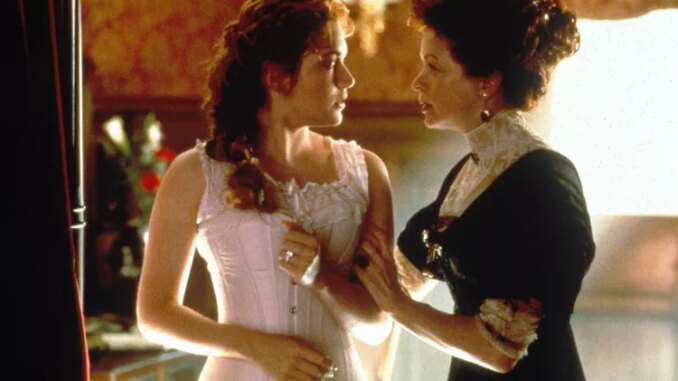
The Unseen Torture of the Gilded Cage: Frances Fisher and the Price of Victorian Glamour on the Titanic Set
Frances Fisher, a seasoned actress with a captivating screen presence, brought an undeniable elegance and strength to the role of Ruth DeWitt Bukater in James Cameron's "Titanic." Ruth, the haughty and financially burdened mother of Rose, was a figure of refined disdain, perpetually draped in the luxurious fabrics and constricting silhouettes of the Edwardian era. While Fisher convincingly portrayed Ruth's societal expectations and manipulative tendencies, behind the character lay the very real discomfort and struggle that came with embodying the restrictive fashion of the time: the corset.
The corset, that seemingly innocuous garment, was more than just a piece of clothing; it was a symbol of social status, feminine ideal, and, as Frances Fisher discovered firsthand, a tool of physical subjugation. In interviews and behind-the-scenes anecdotes, Fisher has openly discussed the challenges she faced wearing a corset for extended periods during filming, illuminating the often-overlooked cost of historical accuracy in cinematic productions. Her experiences offer a glimpse into the unseen torture endured by women in the late 19th and early 20th centuries, a torture masked by the allure of beauty and respectability.
Fisher's discomfort stemmed from the very nature of the corset. Designed to sculpt the female form into an hourglass figure, it achieved this by compressing the rib cage, restricting breathing, and displacing internal organs. As Fisher explains, prolonged wear could lead to shortness of breath, muscle fatigue, and even digestive problems. Imagine, then, having to maintain a poised and controlled demeanor, delivering sharp lines and engaging in intense emotional scenes, all while battling the internal pressures of a rigidly structured undergarment. It demanded a level of physical and mental fortitude that many modern actors may not fully appreciate.
Beyond the physical limitations, the corset also imposed a psychological constraint. Fisher had to consciously adjust her posture, movements, and even her vocal delivery to reflect the restrictive nature of the garment. She couldn't simply slouch, breathe deeply, or move freely; every action had to be calibrated and controlled. This constant awareness of her physicality created a sense of confinement, mirroring the limitations imposed upon women of Ruth's social class. The corset became a tangible representation of the societal pressures to conform, to prioritize appearance over comfort, and to sacrifice personal freedom for the sake of maintaining social standing.
Fisher's experiences highlight the often-unacknowledged sacrifices made by actors in the pursuit of authenticity. While modern audiences may marvel at the stunning costumes and elaborate sets of historical dramas, they often remain oblivious to the physical discomfort and mental strain endured by the performers. Frances Fisher's willingness to discuss her struggles with the corset serves as a reminder that recreating historical accuracy is not merely about replicating the visual aesthetics of the past, but also about understanding the lived experiences of the people who inhabited it.
Furthermore, Fisher's insights extend beyond the realm of filmmaking and offer a valuable commentary on the enduring legacy of restrictive beauty standards. While the corset may be largely relegated to historical reenactments and fetish wear, the pressure on women to conform to unrealistic body ideals persists in modern society. From body-shaping undergarments to cosmetic surgery, the desire to achieve a socially desirable appearance continues to exert a powerful influence on women's lives, often at the expense of their physical and emotional well-being.
In conclusion, Frances Fisher's experiences with the corset on the "Titanic" set offer a unique and compelling perspective on the struggles of embodying a historical character. They illuminate the often-unseen physical and psychological costs associated with restrictive fashion, and serve as a poignant reminder of the sacrifices made by women throughout history in the name of beauty and social acceptance. By sharing her personal challenges, Fisher not only enriches our understanding of the film and the historical period it depicts, but also invites us to critically examine the enduring legacy of restrictive beauty standards in our own society. Her honesty transforms the seemingly mundane detail of a corset into a powerful symbol of female oppression and the ongoing fight for personal freedom and self-acceptance.
